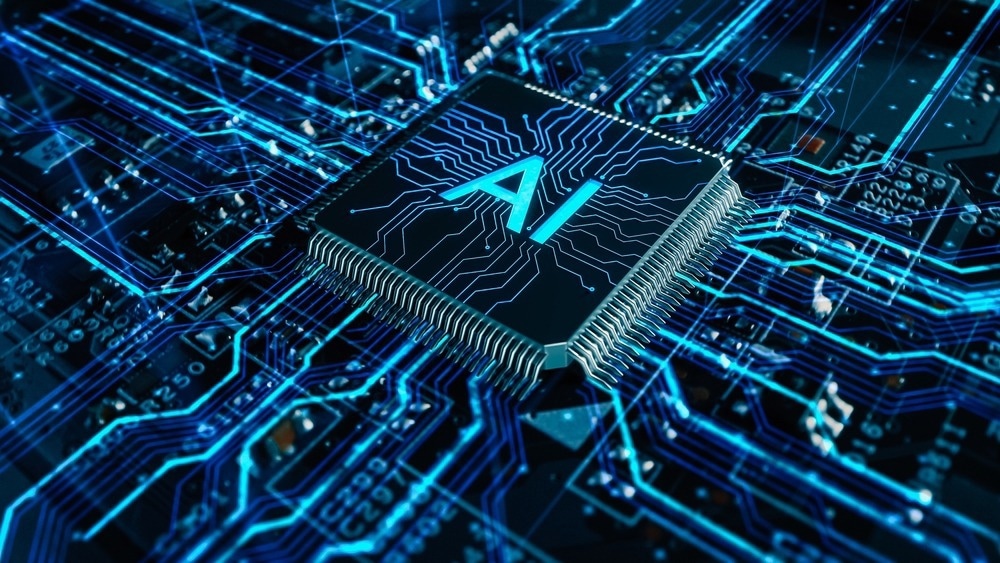In recent years, "artificial intelligence" (AI) has gained significant attention and has had transformative effects on several industries, including the semiconductor industry. The advent of AI and other associated technologies, such as Machine learning (ML), Deep learning (DL), etc., have brought forth new prospects for the semiconductor industry, leading to enhanced productivity, efficiency, and performance while also reducing costs. This article focuses on various ways in which the implementation of AI is causing significant improvements in semiconductor and integrated circuit technology.

Image Credit: Gorodenkoff/Shutterstock.com
Implementation of Machine Learning (ML) in the Semiconductor Industry
The implementation of ML in the semiconductor industry is highly beneficial, especially in terms of predictive maintenance, defect detection, and process control. An article published in the journal Chip focuses on the role of ML in data analysis in the semiconductor industry.
Researchers in semiconductor materials analysis and the fabrication sector are putting forth efforts to develop and implement a variety of novel ML algorithms to make effective use of vast amounts of data. As per the article, the majority of machine learning (ML) tasks related to semiconductors primarily involve classification, predicting various material properties, device performance, and manufacturing processes. As a result, most of the ML applications in this field are primarily based on supervised learning.
The implementation of ML in semiconductor research can be classified into two distinct categories, namely, the development of data models for the material's macroscopic information (such as lattice constant, space group, elastic modulus, etc.) and for the position and type of every atom. These studies enable the prediction of macroscopic and microscopic properties based on the information about each atom, such as machine-learning interatomic potentials (MLIP) or MLFF (machine-learning force fields).
To identify and categorize microchip imperfections, investigators have suggested an automatic defect classification (ADC) method. The primary input is the image captured by a scanning electron microscope. Using a convolutional neural network (CNN) approach, this system can detect virtually without human assistance, as demonstrated by the method's high efficacy in experiments.
Limitations of ML In the Semiconductor Industry
Machine learning is a type of computational artificial intelligence. Some deficiencies are primarily due to inadequate statistical analysis. In material science and semiconductor manufacturing, there is a great deal of data, but sometimes it is insufficient for constructing general ML models, or it is not utilized effectively in certain studies. The greater the generality of a model, the greater the amount of training data required to acquire an effective model. The degree of abstraction for the ML objective should correspond to the amount of training data.
Some results in this discipline lack statistical analysis of the outcomes. It is difficult to ensure the IID condition between training data and the scenario is predicted when applying machine learning to semiconductors.
Insufficient testing in the actual simulation or production process is another significant limitation. The majority of research in this discipline is still at the conceptualization and confirmation stage, so there is still much work to be done.
Expandable Yield Prediction Using AI
There are several hundred operations involved in the manufacturing of semiconductor devices, and numerous factors influence device yields. The latest article published in Applied Sciences targets this issue by employing an extensible input data-based approach to incorporate diverse factors in forecasting and by implementing explainable artificial intelligence (XAI), which uses interpreting models to alter fabrication conditions.
Ten distinct machine learning algorithms are optimized and compared to select the data prediction model with the best performance. The selected RF model exhibits enhanced prediction scores of 0.520 for mean absolute error and 0.648 for root mean square error. This study's findings have significant implications for enhancing the production yields of multiple goods with diversified manufacturing data.
AI for Resolution of Supply Chain Bottlenecks and Chip Quality
The latest article in the International Journal of Research Publication and Reviews focuses on the implementation of AI for solving several problems related to semiconductor manufacturing.
It is reasonable to construct a machine learning model using real-time data extracted from extant datasets in electronic systems. This enables the companies to gather knowledge from real data rather than relying on suppositions in its planning process, thus enhancing the precision of forecasts and enabling it to respond quickly by developing ahead of client demand and utilizing production capacity with greater effectiveness, as well as resolving the issue of machine bottlenecks.
In addition, AI can be used to address problems with product quality caused by voids in current testing and actual visual examination procedures and abilities. Current approaches are dependent on humans, such as additional gates of manual inspections, which not only lengthen the cycle of manufacturing but also increase manufacturing costs.

Image Credit: jiang jie feng/Shutterstock.com
The proposed AI-based solution is to use historical data sources for training an artificial neural network ML model alongside an image processing algorithm to create a flexible decision-assisting tool for more accurate product inspections that use dynamic reference photos for comparison. In the proposed AI solution, the images from the Automated Optical Inspection technology that were transmitted to the FTP server will be subjected to a series of image pre-processing techniques to improve and repair and to extract features using segmentation of colors so that any slight defects on the semiconductor chips can be readily detected.
Genetic Algorithm for Root Cause Failure
The journal Scientific Reports has published an article that seeks to develop a model capable of predicting failure outcomes based on the distinguishing characteristics of failure descriptions. A genetic algorithm (GA) is a subset of AI that simulates the method of natural selection. GA performs search operations in complex, large, multimode environments and provides solutions that are close to optimal. GA-DT refers to the article's combination of a genetic algorithm and a decision tree classifier. Initially, the failure analysis description X is pre-processed. Phase 2 demonstrates the word vectorization technique Word2Vec. On vectorized preprocessed data, Phase 3 demonstrates the use of the GA variable selection technique in conjunction with a decision tree or support vector machine-supervised learning.
The algorithm displays the three most accurate predictions for each text sample failure assessment conclusion. The BLEU score quantifies the analogy between forecasted data and the original collection. The distinguishing characteristics chosen by the suggested GA-DT method provide the most accurate prognostic model of the failure conclusion based on the failure process description.
Market Analysis
As per the report published by McKinsey and Company, AI/ML has an opportunity to create enormous commercial value for semiconductor organizations. AI/ML currently provides between $5 and $8 billion in annual revenue. This is remarkable, but it only represents about 10 percent of AI/ML's maximum industry value. AI/ML could generate between $35 billion and $40 billion within the next two to three years. This demonstrates that the semiconductor industry has reached a tipping point, and businesses that do not devote substantial resources to AI/ML strategies could risk falling behind.
More from AZoM: Can Blockchain Technology Better Plan Semiconductor Supply Chains?
References and Further Reading
Rammal, A. et al. (2023). Root cause prediction for failures in semiconductor industry, a genetic algorithm–machine learning approach. Sci Rep 13, 4934. Available at: https://doi.org/10.1038/s41598-023-30769-8
McKinsey and Company, (2021). Scaling AI in the sector that enables it: Lessons for semiconductor-device makers. [Online]
Available at: https://www.mckinsey.com/industries/semiconductors/our-insights/scaling-ai-in-the-sector-that-enables-it-lessons-for-semiconductor-device-makers
Lee Y, Roh Y. (2023). An Expandable Yield Prediction Framework Using Explainable Artificial Intelligence for Semiconductor Manufacturing. Applied Sciences. 13(4):2660. Available at: https://doi.org/10.3390/app13042660
Liu et. al. (2022). Machine learning for semiconductors. Chip. 1(4):100033. Available at: https://doi.org/10.1016/j.chip.2022.100033
Latha et. al. (2023). A Review on Semiconductor Manufacturing using AI Techniques. A Review on Semiconductor Manufacturing using AI Techniques. 4(3): 1376-1330. Available at: https://ijrpr.com/uploads/V4ISSUE3/IJRPR10490.pd
Disclaimer: The views expressed here are those of the author expressed in their private capacity and do not necessarily represent the views of AZoM.com Limited T/A AZoNetwork the owner and operator of this website. This disclaimer forms part of the Terms and conditions of use of this website.